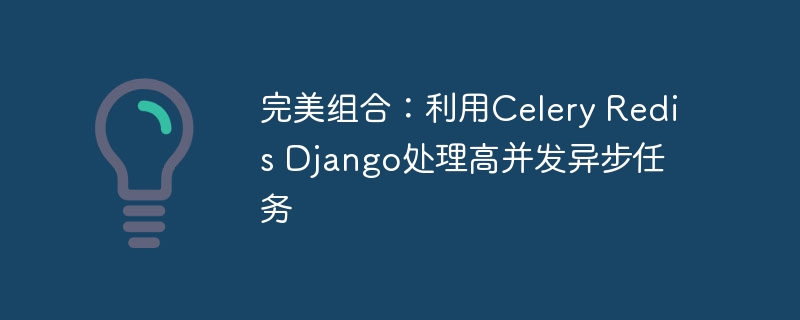Home >Backend Development >Python Tutorial >Perfect combination: Use Celery Redis Django to handle high-concurrency asynchronous tasks
Perfect combination: Use Celery Redis Django to handle high-concurrency asynchronous tasks
- WBOYWBOYWBOYWBOYWBOYWBOYWBOYWBOYWBOYWBOYWBOYWBOYWBOriginal
- 2023-09-27 15:21:151562browse

Perfect combination: Using Celery Redis Django to handle high-concurrency asynchronous tasks
Introduction:
In modern web application development, high concurrency performance and Quick response is crucial. In order to handle the large number of requests and concurrent tasks from users, developers need to leverage reliable and efficient asynchronous task processing tools. Celery, Redis and Django are a perfect combination that can help developers achieve high-concurrency asynchronous task processing. This article explains how to use these three tools together and provides specific code examples.
Subject:
1. What is Celery?
Celery is an asynchronous task queue/job queue library based on distributed messaging, which allows developers to easily distribute tasks to distributed systems. It is a powerful tool often used by Python developers to handle a large number of concurrent tasks.
2. What is Redis?
Redis is an open source in-memory data structure storage system. It stores data in the form of key-value pairs and supports multiple data types such as strings, lists, sets, etc. Redis also has high-speed read and write performance and high availability, which makes it ideal for handling high-concurrency tasks.
3. What is Django?
Django is a Python web framework for building web applications. It provides a simple, flexible, and efficient way to handle web development tasks. Django's asynchronous task module can be seamlessly integrated with Celery and Redis to achieve efficient task processing.
4. How to use Celery, Redis and Django to handle high-concurrency tasks?
The following is a code example that shows how to use Celery, Redis and Django to handle high-concurrency asynchronous tasks.
First, we need to install Celery, Redis and Django:
pip install Celery Redis Django
Then, add the Celery configuration in the settings.py file of the Django project:
# settings.py # Celery配置 CELERY_BROKER_URL = 'redis://localhost:6379/0' CELERY_RESULT_BACKEND = 'redis://localhost:6379/0'
Next, we can create a tasks.py file that contains the definition of asynchronous tasks:
# tasks.py
from celery import shared_task
@shared_task
def send_email_task(email):
# 发送电子邮件的代码
# ...
return 'Email sent successfully'
@shared_task
def process_data_task(data):
# 处理数据的代码
# ...
return 'Data processed successfully'Before using Celery to handle asynchronous tasks, we need to run the Celery worker process. Execute the following command in the command line:
celery -A project worker --loglevel=info
Finally, in the Django view, we can call the asynchronous task:
# views.py
from django.shortcuts import render
from .tasks import send_email_task, process_data_task
def send_email_view(request):
email = request.GET.get('email')
send_email_task.delay(email)
return render(request, 'success.html')
def process_data_view(request):
data = request.GET.get('data')
process_data_task.delay(data)
return render(request, 'success.html')In the above example code, send_email_view and process_data_viewThe view function will respond to the request before calling the asynchronous task and return a success page. The execution of asynchronous tasks will not block the user's request response and can be processed in the background.
Conclusion:
Using the combination of Celery, Redis and Django, we can easily handle high-concurrency asynchronous tasks and improve the performance and response speed of web applications. Through sample code, we demonstrate how to configure and use these tools. I hope this article can help developers learn and practice these powerful asynchronous task processing tools to bring better performance and user experience to their applications.
The above is the detailed content of Perfect combination: Use Celery Redis Django to handle high-concurrency asynchronous tasks. For more information, please follow other related articles on the PHP Chinese website!

